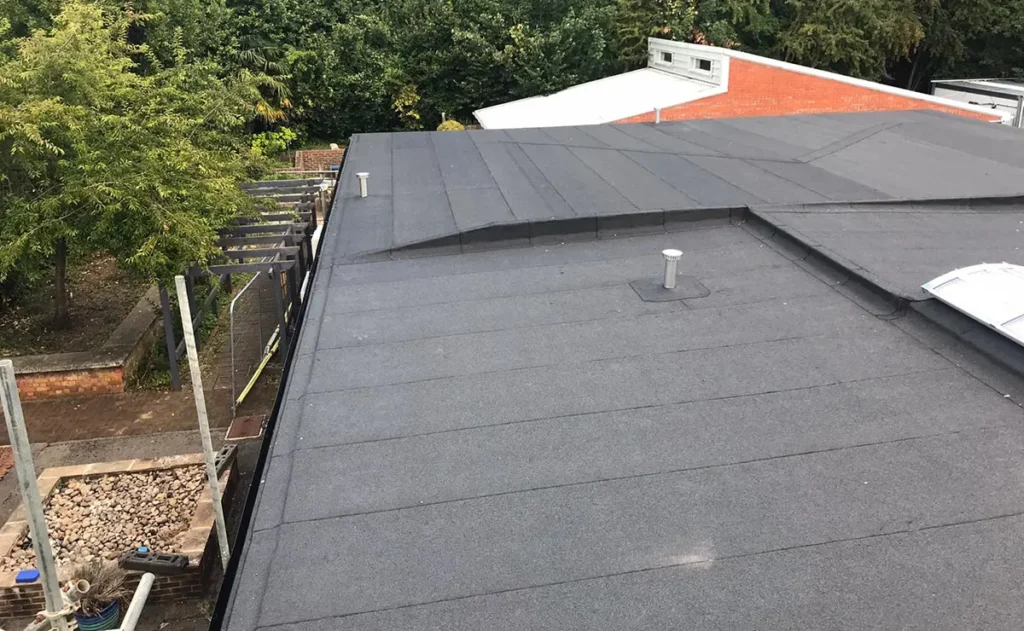Why Flat Roof Tapered Insulation Matters in High Snow Areas
Did you know that the value of the global flat roofing systems market is expected to increase by over ten billion U.S. dollars from 2021 to 2025? The clean lines, modern aesthetic, and functional versatility give this roofing style undeniable appeal. However, if you reside in a higher elevation area with a snowy climate, flat decks and flat roofs can pose challenges such as snow accumulation, water ponding, and structural stress.
This is where flat roof tapered insulation plays a vital role.
What Is a Flat Roof Tapered Insulation System?

Flat roof tapered insulation — also known as a slope-to-drain system — is a strategic method of avoiding water damage by guiding water off the roof and toward internal drains or the roof edge. These systems use subtle slopes built into the insulation to encourage snowmelt and rainwater to flow away from the structure, preventing ponding and potential leaks.
When Would You Need a Tapered Roof System?
Not every roof needs a tapering system, but low-slope roofing systems like TPO and EPDM absolutely do. These membranes are installed using seams, which are highly vulnerable to water intrusion. By using flat roof tapered insulation, you’re controlling the flow of water and reducing the risk of failure. Water is directed to drains, scuppers, or downspouts efficiently.
Why Flat Roofs in Park City Require Tapered Insulation
In regions like Park City, where snowfall can be heavy and prolonged, flat roof tapered insulation is critical. Flat or low-slope roofs in high-elevation climates must be designed to handle large amounts of snow and rain. Without adequate drainage, water can pond, freeze, and overload the structure, increasing the risk of leaks, structural stress, or even collapse.
When to Consider Flat Roof Tapered Insulation
If your building has complex roofing geometries, or if multiple roof sections shed onto a single flat deck, the need for flat roof tapered insulation increases. Intersections, wall joints, and transition points make drainage more complicated, and tapering the insulation helps solve this challenge.
What Roof Types Might Not Require Tapered Insulation?
Some roof systems, like ballasted or green roofs, are designed to retain and drain water naturally. However, when these systems intersect with a flat roof, we still recommend integrating flat roof tapered insulation into the overall drainage plan.
Similarly, hot-applied roofing systems (such as HYDROTECH 6125) are designed to hold water and may not need tapering. Still, for added protection, some builders choose to install tapered insulation underneath, especially in climates where freeze-thaw cycles can be damaging.
Best Practices for Installing Flat Roof Tapered Insulation
Flat roof tapered insulation can be installed in one of two ways:
– Framing taper: Built into the structure by your general contractor.
– Insulation taper: Achieved using pre-cut tapered insulation installed by a roofer like Viotell.
A typical slope is ¼ inch per foot, but this can affect window and door placements — so it’s essential to plan with a trusted contractor. For example, if your door threshold is only two inches high, you may be limited to how far the taper can extend without creating elevation conflicts.
The Role of Experts in Tapered Roof Design
Flat roof project, especially those in snow-heavy areas, benefit greatly from a well-rounded team. Architects, general contractors, and experienced installers all need to collaborate on material selection, slope design, and drainage calculations. In places like Park City, professionals must also factor in snow load, storm frequency, and freeze-thaw cycles.
Architects can help preserve the clean aesthetic of the roof while ensuring water sheds properly. Installers and builders then bring the design to life with correct slope geometry and material installation.
Maintaining Your Flat Roof Tapered Insulation System
Like all roofing systems, flat roof tapered insulation requires ongoing maintenance. After a major snowstorm or rainfall event, it’s important to inspect your roof, clear any blockages, and make any necessary repairs. Schedule regular roof inspections and ensure that drains, scuppers, and gutters are free of debris.
Final Thoughts. Is Flat Roof Tapered Insulation Right for You?
When building or renovating, decisions like these can feel overwhelming, especially when they’re labeled as “optional.” But in climates like Park City’s, flat roof tapered insulation is far from optional. It plays a major role in extending your roof’s lifespan and preventing costly structural issues down the line.
We strongly recommend speaking to an expert to determine whether flat roof tapered insulation is necessary for your project.


